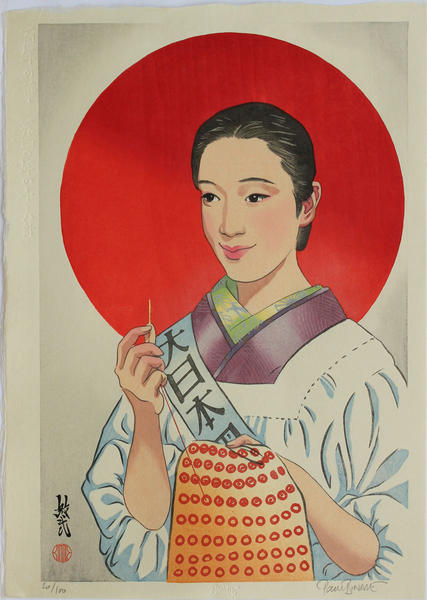| | |
| Artist: | Binnie Paul (1967- ) |
| Title: | Thousand stitch belt — 千人針 |
| Series: | Flowers of a Hundred Years — 百年の花 |
| Date of first edition?: | 2014/4 |
| Date of this artwork?: | 2014 (may not be accurate) |
| Publisher (first edition)?: | Self |
| Publisher (this edition)?: | Self |
| Medium (first edition): | Woodblock |
| Medium (this edition): | Woodblock |
| Format (first edition): | Large Oban
|
| Format (this edition): | Large Oban |
| DB artwork code: | 45181 |
| Notes (first edition)?: |
| From Wiki: 千人針(せんにんばり)は、第二次世界大戦まで日本でさかんに行われた、多くの女性が一枚の布に糸を縫い付けて結び目を作る祈念の手法、および出来上がったお守りのこと。武運長久、つまり兵士の戦場での幸運を祈る民間信仰である。アメリカ合衆国の第442連隊戦闘団(日系志願部隊)でも行われた[1]。現在は海外派遣される自衛官を対象に行われている |
|
| Notes (this edition)?: |
| The following information was taken from the original web listing of this artwork. Note that there may be some inaccuracies:
Senninbari – Thousand stitch belt, the fifth design from the new series Hyakunen no Hana - Flowers of a Hundred Years, self-printed in an edition of 100 in April 2014.
Paper size: 33.5 x 47 cm. Series title and print title in blindprinting in the top left margin; signed in blindprinting and pencil in the bottom margin.
The fifth of a series of 10 bijin prints illustrating women in the decades of the 20th century. |
|
| Artist Bio: |
Paul Binnie was born at Airthrey Castle, Scotland in 1967 and lived in Alloa, Central Scotland until 1985. He then attended Edinburgh University and Edinburgh College of Art, taking his MA (Fine Art) in 1990. From then until the spring of 1993 he lived in Paris where he worked mostly in oils and watercolours, painting figure subjects and occasional landscapes. He began to collect Japanese Woodblock Prints in the late 1980s on a summer trip to Paris, and his extended stay in France allowed him to expand his collection and his knowledge of the subject. It was this interest in Japanese Prints along with a desire to understand the methods of their production that prompted him to move in March 1993 to Tokyo. He there sought training in the techniques of block print-making. Unable to enter the Yoshida studio, his first choice for training, due to the illness of Yoshida Toshi, he was advised to contact Seki Kenji. Kenji had been the head printer at Doi-Hangaten and Binnie worked with him for several years developing his own block printing style.
|
|


